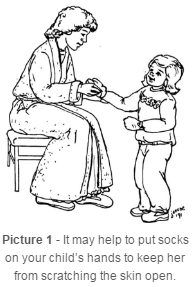Pityriasis Rosea
![]()
Pityriasis rosea (Pit-er-RIE-uh-sis ROSE-ee-uh) is a common skin problem in children and young adults. It often begins with a large scaly lesion called the “herald patch.” Lesions may appear anywhere on the body, but are most commonly found on the trunk, upper arms, neck and thighs. Within days to weeks afterwards, many smaller scaling patches begin to appear. They can continue to appear for weeks. The lesions may be itchy.
What Causes Pityriasis Rosea?
Dermatology
Looking for services or physicians who can help treat this condition?
The cause of pityriasis rosea is not known. Many doctors suspect that a virus causes it. It’s not likely that anyone else in the family would become infected, since it does not spread easily. A case of pityriasis rosea usually lasts from 2 to 6 weeks but may last up to 3 to 4 months. Some children have nothing but non-itchy scaling areas. Others also have low-grade fevers and a lot of itchiness.
Treatment
In time, the lesions will go away on their own. The only treatment needed is to help with the itching. Some children may have areas of change in skin color where the patches are, but this goes away in the following months.
- If your child has a fever you may give acetaminophen. Be sure to follow the instructions on the label.

- Keep your child’s fingernails cut short to keep him from scratching open the skin.
- Placing socks over the child’s hands may help to keep him from scratching.
- If itching continues, you may give Benadryl – a medicine that is available without a prescription.
- Putting a moisturizer on the skin may also help.
- Your child may attend school.
When to Call the Doctor
Call the dermatologist if itching cannot be controlled with over-the-counter medicine.
If you have any questions, be sure to ask your doctor or nurse.
HH-I-201 4/10 Copyright 1999-2010, Nationwide Children’s Hospital

